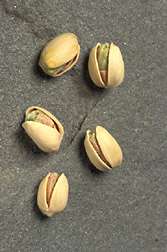Scientists probe yeast's ability to protect tree nuts

(Phys.org) -- U.S. Department of Agriculture (USDA) scientists have moved a step closer to understanding the underlying mechanisms that enable a helpful yeast to disable a mold that attacks tree nuts such as almonds, pistachios, and walnuts. Their on-going laboratory studies may help improve the effectiveness of the yeast, Pichia anomala, in thwarting the mold, Aspergillus flavus.
The mold is of concern because it can produce aflatoxin, a natural carcinogen. Agricultural Research Service (ARS) plant physiologist Sui-Sheng T. (Sylvia) Hua leads the studies. She is based at the ARS Western Regional Research Center in Albany, Calif. ARS is USDA's chief intramural scientific research agency, and the research supports the USDA priority of ensuring food safety.
Federal food safety standards, and quality control procedures at U.S. packinghouses, help ensure that tree nuts remain safe to eat. Nonetheless, growers and processors have a continuing interest in new, environmentally friendly ways to combat the A. flavus mold.
For an early, collaborative experiment by Hua and two other Albany scientists, chemical engineer Bradley J. Hernlem and microbiologist Maria T. Brandl, the mold was exposed to the yeast, and, later, to several different compounds that fluoresce a distinctive red, or green, when evidence of specific changes in the mold's cells is detected.
Results of these fluorescence assays, documented in a peer-reviewed article in the scientific journal Mycopathologia, suggest that the yeast interfered with the mold's energy-generating ATP (adenosine triphosphate) system, vital for the mold's survival. The findings also suggest that the yeast damaged mold cell walls and cell membranes, according to Hua. Walls and membranes perform the essential role of protecting cell contents.
In other work that has helped pave the way to current studies, the team used a different analytical procedure—quantitative reverse transcriptase PCR (polymerase chain reaction) assays—to analyze the activity of certain P. anomala genes in the presence of the mold. Preliminary findings, which Hua reported at the annual national meeting of the American Society for Microbiology in 2010, suggest that exposing the yeast to the mold may have triggered the yeast to turn on genes that code for production of two enzymes—PaEXG1 and PaEXG2. These enzymes are capable of degrading the mold's cell walls and causing damage to membranes.
Though further studies are needed, these early, PCR-based findings point to gene-controlled mechanisms that may be involved in the cell wall and cell membrane damage observed in the fluorescence assays.
Other ARS teams at Albany are also pursuing strategies for fighting A. flavus. Read more about this research in the July 2012 issue of Agricultural Research magazine.
Provided by Agricultural Research Service
















